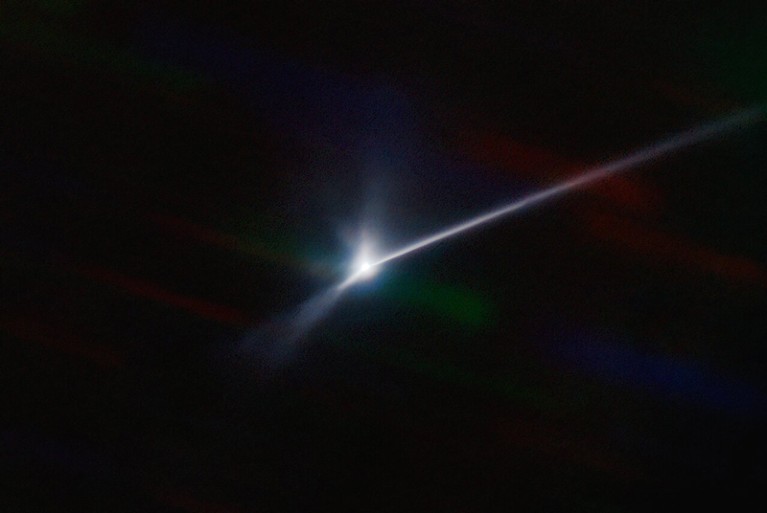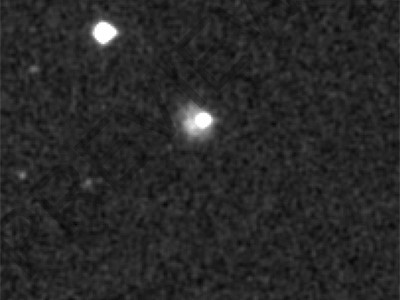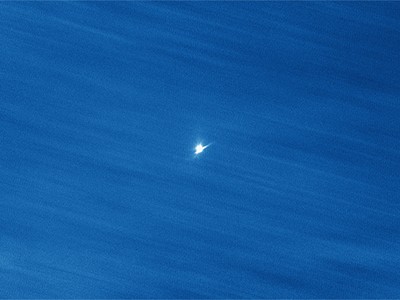
The DART impact ejected vast amounts of dust and debris from the surface of the asteroid Dimorphos. The trail of dust is more than 10,000 kilometres long.Credit: CTIO/NOIRLab/SOAR/NSF/AURA/T. Kareta (Lowell Observatory), M. Knight (US Naval Academy)
When NASA’s Double Asteroid Redirection Test (DART) spacecraft slammed into an asteroid on purpose last September, many telescopes were trained on this one-of-a-kind celestial event. Some were operated by teams of amateur astronomers — skilled skywatchers for whom astronomy is not their full-time day job (or, more accurately, night job). Three such teams on France’s Réunion island in the Indian Ocean, plus one in Nairobi, managed to watch the impact in real time.
These skywatchers are among the authors of a study in Nature that describes how the asteroid, named Dimorphos, became temporarily brighter and redder as the spacecraft hit it1. One of five papers about the impact published in Nature1–5, it describes a real-time view of a cosmic collision — similar to that when Comet Shoemaker–Levy 9 slammed into Jupiter in July 1994.
Read the paper: Light curves and colours of the ejecta from Dimorphos after the DART impact
The four telescopes were of a type that has become popular in the amateur-astronomy community, with 112-millimetre-diameter mirrors. Manufactured by Unistellar, based in Marseille, France, they come with an app that uploads observational data to the company’s server, so professional astronomers can quickly combine and analyse records of an event made by their amateur associates.
It’s the latest example in the long-running story of how amateur stargazers have assisted in making observations of the night sky. In the past, for example, astronomers have improved their understanding of variable stars — those whose brightness as seen from Earth changes with time — by tapping into an extensive database of observations built partly by amateur astronomers as part of a global network called the American Association of Variable Star Observers. Other such community-science efforts include helping working astronomers to categorize galaxies, and sifting through cosmic signals in search of any that might be coming from extraterrestrial civilizations. Amateur astronomers routinely discover comets and other celestial events, as well as identify previously undescribed phenomena and objects from old photographs of the night sky. In 2020, for instance, Italian amateur astronomer Giuseppe Donatiello discovered three dwarf galaxies orbiting a distant galaxy, just by going through public data from the Dark Energy Survey, recorded by a telescope in Chile.
Asteroid lost 1 million kilograms after collision with DART spacecraft
Coordination between amateur and professional researchers is not unique to astronomy. In January, researchers unveiled a model called BirdFlow, which uses machine learning to predict where 11 North American bird species will migrate to6. They explained that this was made possible because of the amateur ornithologists who contribute several million records of bird sightings to an online database called eBird every year.
Whatever the discipline, community science collects data from many contributors, which must be checked and calibrated. The payoff is that the more people can confirm an observation, the more robust that observation becomes. In the case of the DART impact, the amateur scientists were able to rapidly gather, distribute and publish information about the event. Other teams of amateurs continue to monitor the DART asteroid system. For example, a French–Greek effort supported by the European Space Agency includes amateur observations and aims to refine our understanding of the system’s orbit around the Sun.
As science becomes ever-more specialized and dependent on ever-more-specific instrumentation, it is tempting to think that the day of the amateur scientist is over. But this would be wrong. More working researchers in more fields should think about how they can harness the enthusiasm of their amateur colleagues in creative ways.
The next time you’re looking for an observation partner or someone to help crunch data, consider the amateur.



